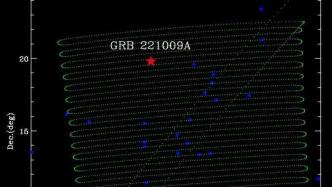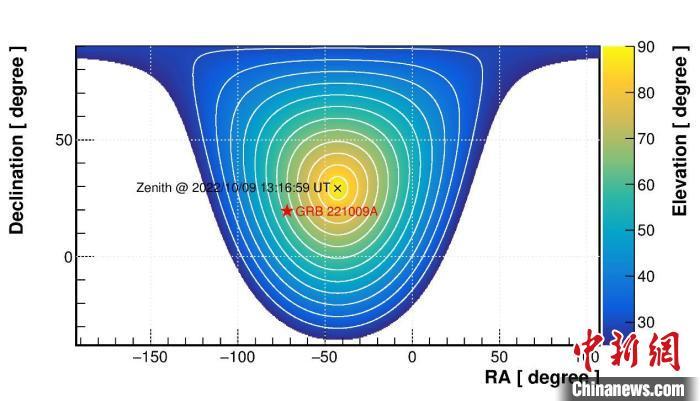

The location of GRB 221009A in the LHAASO field of view at the time of the eruption. Photo courtesy of Institute of High Energy, Chinese Academy of Sciences
The Chinese High-Altitude Cosmic Ray Observatory (LHAASO, nicknamed "Lasso"), the "High-Energy Explosion Explorer" (HEBS) and the "Insight" satellites are responsible for the construction and operation management of the Institute of High Energy Physics of the Chinese Academy of Sciences (IHEP). -HXMT) and other three major scientific devices, recently through the combination of heaven and earth, and at the same time detected the brightest gamma-ray burst numbered GRB 221009A so far, breaking the gamma-ray burst photons with the highest energy and brightest gamma rays in the universe observed by humans. Multiple records of horse ray bursts.
More than 10 times brighter than the brightest gamma-ray burst ever
According to the Institute of High Energy, Chinese Academy of Sciences, the brightest GRB 221009A gamma-ray burst in history was simultaneously detected by the three major scientific devices of the institute at 21:17 on October 9, Beijing time. In this observation, "Lasso" increased the highest energy record of gamma-ray burst photons by nearly 20 times, and opened the 10 trillion electron volt band Gamma-ray burst observation window for the first time in the world. Together with the observations of the High Energy Burst Explorer, it was found that this cosmic event was more than 10 times brighter than the brightest gamma-ray burst ever observed by humans.
Gamma-ray bursts, the most violent celestial explosions in the universe, were first discovered in the 1960s. Gamma-ray bursts are as short as milliseconds and as long as hours, releasing more energy than the sun radiates in its lifetime combined. Gamma-ray bursts of longer duration are produced by the collapse and explosion of stellar bodies dozens of times larger than the sun, while gamma-ray bursts of short duration are produced by the merger and explosion of two compact celestial bodies (such as black holes or neutron stars), and then It may also be accompanied by the emission of gravitational waves.
Thanks to the rapid development of the space-earth integrated observation capability building of the Institute of High Energy of the Chinese Academy of Sciences in recent years, especially the successful construction and operation of the "Lasso" occupying an international leading position, China has realized the first multi-method joint observation of gamma-ray bursts. , and exclusively achieves from the highest ten trillion electron volt photons ("Lasso") to mega electron volt gamma rays ("High Energy Burst Explorer") and kiloelectron volt X-rays ("Wisdom Eye" satellite) Multi-spectral fine measurement, spanning 9 orders of magnitude.
High-energy physicists believe that these observations have broken many records of gamma-ray burst observations and are of great value in revealing the burst mechanism of gamma-ray bursts.
Timely release of observations to the international community has aroused huge repercussions
The Institute of High Energy of the Chinese Academy of Sciences pointed out that the high-intensity burst of the GRB 221009A gamma-ray burst observed this time occurred at a distance of more than 2 billion light-years from the earth. It is estimated that such a close gamma-ray burst occurs only once every few decades or even a hundred years. . Of the thousands of gamma-ray bursts detected over the past half century, the highest-energy photons reached about 1 trillion electron volts. This time, "Lasso" detected a large number of high-energy photons with unparalleled acceptance, and the highest photon energy reached 18 trillion electron volts.
After the GRB 221009A gamma-ray burst, the "Lasso" experiment team from the Institute of High Energy, Chinese Academy of Sciences, led by the chief scientist Cao Zhen, quickly carried out data analysis, and within less than two days after the burst, it passed the Gamma-ray Burst Collaborative Observation Network (GCN) Publish preliminary observations to international peers. Further data analysis and scientific research are being carried out by the members of the "Lasso" international cooperation group. The observation and operation team, payload team and data analysis team of the "Huiyan" satellite and "High-energy Explosion Explorer" of the Institute of High Energy, Chinese Academy of Sciences are led by researcher Zhang Shuangnan, chief scientist of the "Huiyan" satellite, and researcher Xiong Shaolin, chief scientist of the "High-energy Explosion Explorer" project. , is rapidly investing in observation and analysis, and in time to start opportunistic observation. Under the close cooperation of the project team, the "Huiyan" satellite and "High Energy Burst Explorer" have obtained preliminary analysis results and released them to international counterparts through the astronomical telegraph and the gamma-ray burst collaborative observation network.
The result of Chinese scientists detecting the brightest gamma-ray burst to date has caused huge international repercussions. A large number of related studies have been carried out rapidly, and many discussions about new physical possibilities have emerged. At the same time, these measurements will place strong constraints on fundamental physical parameters and models such as the background light field that exists in the universe, and are expected to yield important cognitive improvements.
It is extremely important for establishing the model of the burst mechanism of gamma-ray bursts
The research team of the Institute of High Energy, Chinese Academy of Sciences said that this time, the "Lasso" recorded tens of thousands of photon signals in the very high energy region above 100 billion electron volts, which will give the most precise measurement of the light curve of the highest energy band of the gamma-ray burst. With advanced detector design, "High-Energy Burst Explorer" successfully observed the soft gamma-ray optical variation characteristics of GRB 221009A gamma-ray burst with high precision, perfectly showing the evolution process of the initial burst and the subsequent flare. For the first time, the high-energy, medium-energy and low-energy X-ray telescopes of the "Huiyan" satellite detected the signal simultaneously in the observation of the gamma-ray burst, and because the "Huiyan" satellite was scanning the sky area at the time, it was the brightest gamma ray to date. The afterglow of the storm was monitored in time. These measurements, which differ in energies by a billion times, are extremely important for correctly modeling the mechanism of gamma-ray bursts.
"Lasso" is a major national scientific and technological infrastructure with the core of cosmic ray observation and research. It was independently proposed and designed by China. The observatory is located in Haizi Mountain, 4,410 meters above sea level in Daocheng County, Sichuan Province. The main project will be completed and put into scientific operation in July 2021. It is currently the most sensitive ultra-high-energy gamma-ray observatory in the world. Gamma Astronomy" The Age of Observations. Capturing and high-statistical observation of gamma-ray bursts is one of the important scientific goals of "Lasso". This unprecedented burst of brightness happened near the center of the "Lasso" field of view, laying a strong foundation for the completion of this scientific goal. Observational basis.
The "Huiyan" satellite is China's first space X-ray astronomical satellite. It was launched in June 2017 and has achieved a large number of important original achievements in black holes, neutron stars, fast radio storms, etc.
Launched in July 2022, "High-Energy Explosion Explorer" is one of the main scientific payloads of China's recently launched space new technology test satellites. The quasi-real-time satellite-to-earth communication scheme can quickly download observation data. The "High-Energy Explosion Explorer" is currently in the on-orbit testing stage and is expected to obtain more important results.


